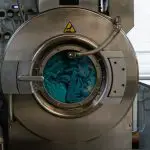Do you ever wonder how those long rolls of paper, plastic, or metal are cut into smaller, more manageable sizes? That’s where a slitting machine comes in.
A slitting machine is a specialized piece of equipment that cuts large rolls of materials into narrower widths that are easier to handle and use for various applications. Slitting machines are commonly used in the manufacturing industry for a variety of materials, such as paper, plastic films, aluminum foil, and steel.
They are essential in creating products such as packaging materials, labels, tapes, and even automotive parts. In this article, we will explore what a slitting machine is, the different types available, and the components that make up this machine.
We will also discuss some factors to consider when choosing a slitting machine, maintenance and safety tips, and the future of slitting machines.
Table of Contents
What is a Slitting Machine?
You may not realize it, but a slitting machine is the unsung hero behind many of the products you use every day, effortlessly slicing materials into precise widths. It’s a machine used in manufacturing to cut large rolls of material, such as paper, film, or fabric, into narrower rolls. This process is called slitting, hence the name of the machine.
The slitting machine works by unwinding the large roll of material, passing it through a series of blades or rollers, and rewinding the material onto new, narrower rolls. The blades or rollers can be adjusted to cut the material into various widths, depending on the needs of the manufacturer. The process can be automated or manual, with some machines even capable of cutting multiple rolls at once.
Slitting machines are used in a wide range of industries, from packaging and printing to automotive and electronics. They’re essential for creating products like adhesive tape, labels, and even medical dressings. Without these machines, it would be incredibly difficult and time-consuming to cut materials into precise widths, making the manufacturing process much less efficient.
Types of Slitting Machines
Now, let’s talk about the different types of slitting machines. You might be wondering about the differences between shear and razor blade machines.
Well, shear machines use a cutting method that involves two blades coming together, while razor blade machines use a single, sharp blade to make cuts. Both types have their advantages and disadvantages, so it’s important to understand which one is best suited for your specific needs.
Differences between Shear and Razor Blade Machines
If you’re looking for precision cuts, a razor blade machine might be the better choice over a shear machine. While both types of slitting machines are used to create narrow strips of material, they differ in their cutting methods.
The main differences between shear and razor blade machines are:
-
Shear machines use a scissor-like cutting action to slice through the material, creating a clean cut with minimal burrs. This method is ideal for thicker materials and creates a straight edge.
-
On the other hand, razor blade machines use a rotating circular blade to make a precise, clean cut. This method is ideal for thinner materials and can create a variety of shapes and angles.
Ultimately, the choice between a shear and razor blade machine depends on the specific needs of your project. If you’re working with thicker materials and need a straight cut, a shear machine might be the better choice. However, if you require precise cuts on thinner materials with complex shapes, a razor blade machine is likely the better option.
Advantages and Disadvantages of each type
Looking at the advantages and disadvantages of shear and razor blade methods, it’s important to consider the material being cut and the desired outcome.
Shear cutting machines are ideal for cutting thicker materials like metal sheets, while razor blade machines are preferred for thinner materials like plastic films. Shear machines are also more versatile and can handle a wider range of materials, while razor blade machines are more precise and can produce cleaner cuts.
One disadvantage of shear machines is that they tend to leave a rough edge on the cut material, which may require additional finishing. On the other hand, razor blade machines require more maintenance and blade replacement, which can be costly. Additionally, razor blade machines may not be suitable for cutting certain materials that are prone to tearing or stretching, which can result in uneven cuts.
Ultimately, the choice between shear and razor blade methods will depend on the specific needs of the user and the materials being cut.
Components of a Slitting Machine
The key to the efficiency of a slitting machine lies in its various components, which work in tandem to produce high-quality slit materials. These machines are equipped with several key components that play a vital role in the slitting process.
Here are the main components of a slitting machine:
-
Unwind Section: This component is responsible for unwinding the material from the roll, which is then fed into the slitting section. It’s equipped with various features to ensure the material is fed smoothly and precisely into the machine.
-
Slitting Section: This is where the actual slitting process occurs. The slitting section consists of blades that cut the material into the desired widths. The number of blades used depends on the number of slits required. The blades are also adjustable, so the operator can change the width of the slits.
-
Rewind Section: Once the material has been slit, it’s wound onto a new roll in the rewind section. This component is equipped with various features to ensure the material is rewound smoothly and without any defects. The rewind section is also adjustable, so the operator can control the tension of the material during the rewinding process.
Overall, each component of a slitting machine plays a crucial role in the slitting process, ensuring that the material is slit accurately and efficiently. Understanding the function of each component is essential for the operator to run the machine effectively and produce high-quality slit materials.
Factors to Consider When Choosing a Slitting Machine
When choosing a slitting machine, you need to consider several factors to ensure that it meets your specific needs.
Firstly, you should consider the material type and thickness that you’ll be working with.
Secondly, you need to determine the width and diameter of the rolls that you’ll be processing.
Lastly, you should consider the production speed and accuracy that you require for your operations.
By taking these factors into account, you can select a slitting machine that’ll provide you with the best results.
Material Type and Thickness
With a slitting machine, you can easily cut through any material type and thickness, making your production process faster and more efficient. However, it’s important to consider the type and thickness of the material you’ll be cutting when choosing a slitting machine.
Here are three things to keep in mind:
-
If you’ll be cutting thicker materials, you’ll need a slitting machine with a higher horsepower and larger blades. This’ll ensure that the machine can handle the thickness and cut through the material with ease.
-
Different materials require different types of blades. For example, if you’re cutting paper or film, you’ll need a slitting machine with razor blades. However, if you’re cutting metal, you’ll need a machine with rotary blades.
-
The width of the material is also an important factor to consider. Make sure that the slitting machine you choose can accommodate the width of the material you’ll be cutting. This’ll prevent any issues with the machine and ensure that the cuts are precise.
Considering these factors when choosing a slitting machine will ensure that you get the right machine for your needs. This, in turn, will help to improve your production process and increase efficiency.
Width and Diameter of Rolls
Now that you understand the different types of materials and their thicknesses that can be used with a slitting machine, let’s move on to the next important factor: the width and diameter of rolls. This is crucial when it comes to determining the type of slitting machine that will be best suited for your needs.
The width of the roll refers to the distance across the material being processed, while the diameter refers to the size of the roll itself. These factors are important to consider because they can impact the efficiency and accuracy of the slitting process.
For example, if you have a large diameter roll but a small width, you may need a slitting machine with a larger blade diameter to ensure a clean cut. On the other hand, if you have a narrow roll with a large diameter, you may need a slitting machine with a smaller blade diameter to avoid any damage to the material.
By taking these factors into consideration, you can ensure that your slitting machine is optimized for your specific needs.
Production Speed and Accuracy
You’ll be thrilled to know that production speed and accuracy are the key factors that will take your material processing to the next level. With slitting machines, you can customize the processing speed to fit your specific needs. Generally, slitting machines can process materials at speeds ranging from 100 meters per minute to 1200 meters per minute. Thus, you have greater control over the speed of the processing line, and you can easily adjust it depending on the type of material you are working with.
Accuracy is also a critical factor in material processing. Slitting machines are designed to make precise cuts that meet your specifications. The accuracy of the cuts is determined by the machine’s cutting-edge, which is made of high-quality materials. A slitting machine’s cutting-edge is sharp, durable, and can cut through a wide range of materials with precision. To understand the impact of speed and accuracy on your material processing, consider the following table:
| Speed | Accuracy | Quality |
|---|---|---|
| Slow | Low | Poor |
| Medium | Medium | Average |
| Fast | High | Excellent |
As you can see from the table, when you combine high production speed with high accuracy, you get excellent quality products. This means you can process large quantities of materials quickly without compromising on the quality of the finished product. So, investing in a slitting machine that offers high production speed and accuracy can be a game-changer for your business.
Maintenance and Safety
Proper maintenance and safety protocols are crucial when operating a slitting machine to ensure the longevity of the equipment and the safety of operators.
To keep the machine running smoothly, it’s important to conduct regular maintenance checks. This includes inspecting the blades, lubricating moving parts, and cleaning the machine. Failure to perform regular maintenance can result in decreased production speed, decreased accuracy, and even damage to the machine.
In addition to regular maintenance, safety protocols must also be followed to prevent accidents and injuries. Operators should always wear appropriate personal protective equipment, such as safety glasses and gloves, and be trained on how to properly operate the machine.
It’s important to keep the work area clean and free of clutter to prevent tripping hazards, and to never exceed the machine’s maximum capacity or attempt to adjust the machine while it’s running.
Taking the time to properly maintain and operate a slitting machine can save time and money in the long run. It can prevent costly repairs and downtime due to accidents or machine failure. By following safety protocols and conducting regular maintenance checks, operators can ensure the longevity of the equipment and the safety of themselves and their colleagues.
Future of Slitting Machines
Looking ahead, the future of slitting machines seems promising, with advancements in technology and automation streamlining the slitting process. Here are three ways that the future of slitting machines is shaping up:
-
Increased automation: Automation is already making its mark on the slitting industry, and this trend is likely to continue. With advancements in sensors, robotics, and artificial intelligence, slitting machines are becoming more autonomous than ever before. This means that operators will be able to focus on more complex tasks, while the machines handle the repetitive and mundane work.
-
Integration with other systems: Slitting machines are increasingly being integrated with other systems, such as quality control and material handling. This integration allows for seamless communication between different processes, leading to increased efficiency and productivity. As these integrations become more advanced, slitting machines will become even more powerful tools for manufacturers.
-
Improved safety features: Safety is always a concern when it comes to heavy machinery. Fortunately, slitting machines are becoming safer than ever before. New safety features, such as automatic e-stop buttons and safety light curtains, are being incorporated into slitting machines to prevent accidents and injuries. As these safety features become more widespread, the risk of accidents will continue to decrease.
- Is Organza Always Silk? - April 23, 2024
- Why Is Organza so Expensive? - April 23, 2024
- Is Organza Soft or Stiff? - April 23, 2024







